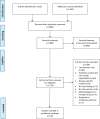Bridging the impactibility gap in population health management: a systematic review
- PMID: 34930736
- PMCID: PMC8689179
- DOI: 10.1136/bmjopen-2021-052455
Bridging the impactibility gap in population health management: a systematic review
Abstract
Objectives: Assess whether impactibility modelling is being used to refine risk stratification for preventive health interventions.
Design: Systematic review.
Setting: Primary and secondary healthcare populations.
Papers: Articles published from 2010 to 2020 on the use or implementation of impactibility modelling in population health management, reported with the terms 'intervenability', 'amenability', and 'propensity to succeed' (PTS) and associated with the themes 'care sensitivity', 'characteristic responders', 'needs gap', 'case finding', 'patient selection' and 'risk stratification'.
Interventions: Qualitative synthesis to identify themes for approaches to impactibility modelling.
Results: Of 1244 records identified, 20 were eligible for inclusion. Identified themes were 'health conditions amenable to care' (n=6), 'PTS modelling' (n=8) and 'comparison or combination with clinical judgement' (n=6). For the theme 'health conditions amenable to care', changes in practice did not reduce admissions, particularly for ambulatory care sensitive conditions, and sometimes increased them, with implementation noted as a possible issue. For 'PTS modelling', high costs and needs did not necessarily equate to high impactibility and targeting a larger number of individuals with disorders associated with lower costs had more potential. PTS modelling seemed to improve accuracy in care planning, estimation of cost savings, engagement and/or care quality. The 'comparison or combination with clinical judgement' theme suggested that models can reach reasonable to good discriminatory power to detect impactable patients. For instance, a model used to identify patients appropriate for proactive multimorbid care management showed good concordance with physicians (c-statistic 0.75). Another model employing electronic health record scores reached 65% concordance with nurse and physician decisions when referring elderly hospitalised patients to a readmission prevention programme. However, healthcare professionals consider much wider information that might improve or impede the likelihood of treatment impact, suggesting that complementary use of models might be optimum.
Conclusions: The efficiency and equity of targeted preventive care guided by risk stratification could be augmented and personalised by impactibility modelling.
Keywords: public health; risk management; therapeutics.
© Author(s) (or their employer(s)) 2021. Re-use permitted under CC BY-NC. No commercial re-use. See rights and permissions. Published by BMJ.
Conflict of interest statement
Competing interests: AB has received a research grant from Medtronic and his unit receives funding from Dr Foster, a wholly owned subsidiary of Telstra Health. The other authors declare no competing interests.
Figures



References
-
- Billings J, Dixon J, Mijanovich T, et al. . Case finding for patients at risk of readmission to hospital: development of algorithm to identify high risk patients. BMJ 2006;333:327–30. 10.1136/bmj.38870.657917.AE - DOI - PMC - PubMed
Publication types
MeSH terms
LinkOut - more resources
Full Text Sources
Miscellaneous
